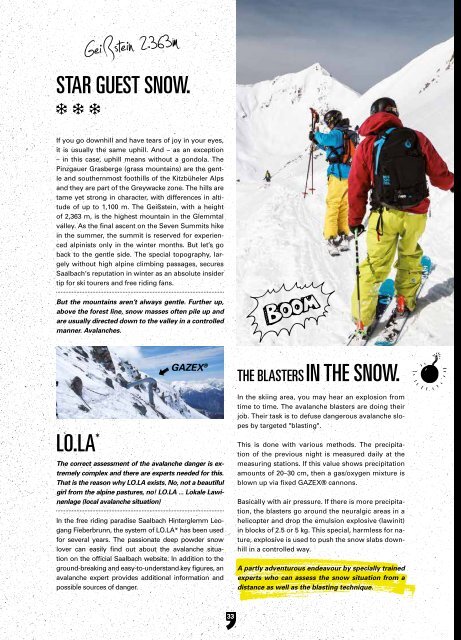eva_magazin_2018_19_rz_WEB_ENG
Komma Magazin 2018/2019
Komma Magazin 2018/2019
You also want an ePaper? Increase the reach of your titles
YUMPU automatically turns print PDFs into web optimized ePapers that Google loves.
Geißstein 2.363m<br />
STAR GUEST SNOW.<br />
If you go downhill and have tears of joy in your eyes,<br />
it is usually the same uphill. And – as an exception<br />
– in this case, uphill means without a gondola. The<br />
Pinzgauer Grasberge (grass mountains) are the gentle<br />
and southernmost foothills of the Kitzbüheler Alps<br />
and they are part of the Greywacke zone. The hills are<br />
tame yet strong in character, with differences in altitude<br />
of up to 1,100 m. The Geißstein, with a height<br />
of 2,363 m, is the highest mountain in the Glemmtal<br />
valley. As the final ascent on the Seven Summits hike<br />
in the summer, the summit is reserved for experienced<br />
alpinists only in the winter months. But let’s go<br />
back to the gentle side. The special topography, largely<br />
without high alpine climbing passages, secures<br />
Saalbach's reputation in winter as an absolute insider<br />
tip for ski tourers and free riding fans.<br />
But the mountains aren’t always gentle. Further up,<br />
above the forest line, snow masses often pile up and<br />
are usually directed down to the valley in a controlled<br />
manner. Avalanches.<br />
LO.LA * GAZEX ®<br />
The correct assessment of the avalanche danger is extremely<br />
complex and there are experts needed for this.<br />
That is the reason why LO.LA exists. No, not a beautiful<br />
girl from the alpine pastures, no! LO.LA ... Lokale Lawinenlage<br />
(local avalanche situation)<br />
In the free riding paradise Saalbach Hinterglemm Leogang<br />
Fieberbrunn, the system of LO.LA* has been used<br />
for several years. The passionate deep powder snow<br />
lover can easily find out about the avalanche situation<br />
on the official Saalbach website. In addition to the<br />
ground-breaking and easy-to-understand key figures, an<br />
avalanche expert provides additional information and<br />
possible sources of danger.<br />
THE BLASTERS IN THE SNOW.<br />
In the skiing area, you may hear an explosion from<br />
time to time. The avalanche blasters are doing their<br />
job. Their task is to defuse dangerous avalanche slopes<br />
by targeted "blasting".<br />
This is done with various methods. The precipitation<br />
of the previous night is measured daily at the<br />
measuring stations. If this value shows precipitation<br />
amounts of 20–30 cm, then a gas/oxygen mixture is<br />
blown up via fixed GAZEX® cannons.<br />
Basically with air pressure. If there is more precipitation,<br />
the blasters go around the neuralgic areas in a<br />
helicopter and drop the emulsion explosive (lawinit)<br />
in blocks of 2.5 or 5 kg. This special, harmless for nature,<br />
explosive is used to push the snow slabs downhill<br />
in a controlled way.<br />
A partly adventurous endeavour by specially trained<br />
experts who can assess the snow situation from a<br />
distance as well as the blasting technique.<br />
33








